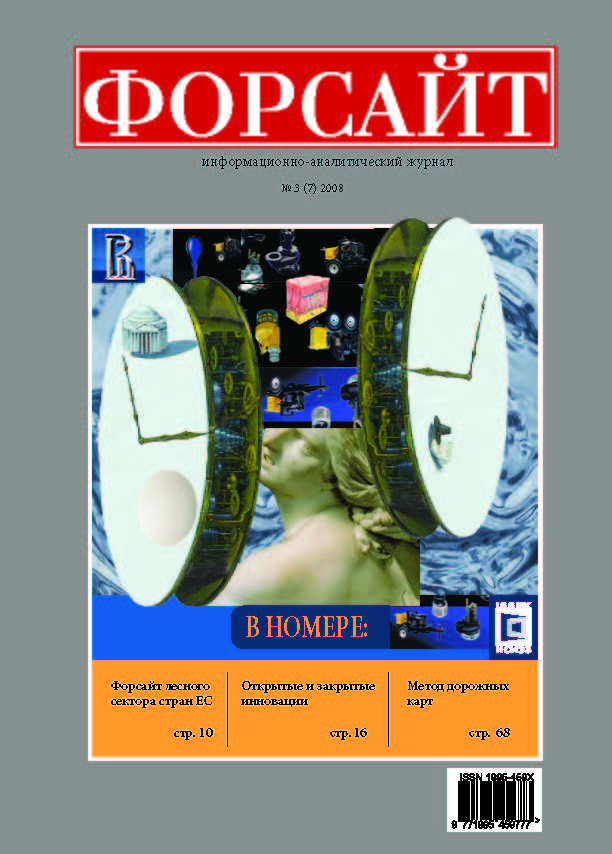Аннотация
В работе представлены результаты исследования инновационной деятельности компаний, проводившегося в девяти странах: Австрии, Бразилии, Канаде, Дании, Франции, Новой Зеландии, Норвегии, Корее и Великобритании. Выявлено, что инновационные компании в указанных странах используют следующие практики (или их комбинацию): 1) новые для рынка инновации; 2) имитации на основе маркетинга; 3) модернизацию процессов; 4) «расширенную» инновационную деятельность. Степень влияния таких факторов, как права на интеллектуальную собственность, приобретение технологий извне, дизайн и маркетинг, на указанные модели инновационной активности варьируется от страны к стране. Так, в Австрии, Дании и Новой Зеландии при создании новых продуктов использование собственных технологий сочетается с импортом результатов исследований и разработок, что говорит о более открытых инновационных схемах. Во Франции и Великобритании, напротив, компании уделяют больше внимания защите прав на интеллектуальную собственность (патенты, авторские права, регистрация промышленных образцов), часто игнорируя возможности использования «внешних» технологий. Подобный подход к инновациям считается «закрытым».
Литература
Acha V. Demand and Design Choices in an Open Innovation System. Paper presented at the CIS user group, London, 17 November 2006.
Acha V. Open by design: the role of design in open innovation. Report to the Department for Innovation, Universities and Skills, 2007.
Acha V., Salter A. Oslo manual revision 3 workshop for a chapter on the 'Economics of Innovation'. Workshop report for the Department of Trade and Industry, November 2004.
Andersen B., Konzelmann S. In Search of a Useful Theory of the Productive Potential of Intellectual Property Rights / Research Policy, 2008, № 37, p. 12-28.
Archibugi D., Pianta M. Measuring technological change through patents and innovation surveys / Technovation, 16 (9), 1996, p. 451-68.
Battisti G., Stoneman P. How innovative are UK firms? Evidence from the CIS4 on the synergistic effects of innovations. Report for the Department of Trade and Industry, 2007.
Blind K., Edler J., Frietsch R., Schmoch F. Motives to patent: empirical evidence from Germany / Research Policy, 2006, № 35, p. 655-672.
Cassiman B., Veugelers R. In Search of Complementarity in the Innovation Strategy: Internal R&D and External Knowledge Acquisition. 2005.
Chesbrough B. Open Innovation: The New Imperative for Creating and Profiting from Technology. 2003.
Cohen W. Empirical studies of innovation activity. In: Stoneman P. (ed.). Handbook of the Economics of Innovation and Technological Change. Oxford: Blackwell, 1995, p. 182-264.
Cox H., Frenz M. Innovation and performance in British-based manufacturing industries: shaping the policy agenda / The Business Economist, 2002, № 33, p. 24-33.
Diellal F., Gallouji F. Innovation surveys for service industries: a review. In: Thuriaux B., Arnold E., Couchot C. (eds.). Innovation and Enterprise Creation: Statistics and Indicators. Luxembourg: European Commission, 2001.
Fagerberg J. Innovation: a guide to the literature. In: Fagerberg J., Mowery D., Nelson R.R. (eds.). The Oxford Handbook of Innovation. Oxford: Oxford University Press, 2005, p. 1-26.
Fidell L.S., Tabachnick B.G. Using Multivariate Statistics. 5th ed. Allyn & Bacon, 2006.
Freeman C. Technology Policy and Economic Performance: Lessоns from Japan. London and New York: Pinter, 1987.
Geroski P.A., Machin S., van Reenen J. The profitability of innovating firms / Rand Journal of Economics, 1993, № 24, p. 198-211.
Haagedorn J. Inter-firm R&D partnerships. An overview of major trends and patterns since 1960 / Research Policy, 2002, № 31, p. 477-492.
Haagedorn J. Sharing intellectual property rights - an exploratory study of joint patenting amongst companies / Industrial and Corporate Change, 2003, № 12, p. 1035-50.
Hollenstein H. Innovation modes in the Swiss service sector: a cluster analysis based on firm-level data / Research Policy, 2003, № 32, p. 845-863.
Howells J.,Tether B. Changing Understanding of Innovation in Services. Draft report for DTI, 2007.
Jensen M.B., Johnson B., Lorenz E., Lundvall B.-A. Forms of knowledge and modes of innovation / Research Policy, 2007.
Laursen K., Salter A. The paradox of openness: appropriability and the use of external sources of knowledge for innovation. Paper presented at the Academy of Management Conference, Hawaii, August 2005.
Lundvall B.-A. National Systems of Innovation: Towards a Theory of Innovation and Interactive Learning. London: Pinter, 1992.
Mowery D.C. America's industrial resurgence: an overview of US Industry in 2000: Studies in Competitive Performance. Washington: National Academy Press, 1999, p. 1-16.
Nelson R.R. National Innovation Systems. A Comparative Study. Oxford: Oxford University Press, 1993.
OECD and Eurostat. Oslo Manual: The Measurement of Scientific and Technological Activities. Guidelines for Collecting and Interpreting Innovation Data. 3rd ed. Paris: OECD, Eurostat, 2005.
OECD. Economic survey of Brazil 2006. Paris: OECD, 2006a.
OECD. Economic survey of Canada 2006. Paris: OECD, 2006b.
OECD. Oslo Manual: The Measurement of Scientific and Technological Activities. Proposed Guidelines for Collecting and Interpreting Technological Innovation Data 2nd ed. Paris: OECD, 1996.
OECD. Survey of Austria 2007: Improving innovation. Paris: OECD, 2007.
Peeters L., Swinnen G.,Tiri M. Patterns of innovation in the Flemish business sector: a multivariate analysis of CIS-3 firm-level data. Report for the IWT-Studies. Brussels, 2004.
Schumpeter A. The Theory of Economic Development: An Inquiry into Profits, Capital, Credit, Interest and the Business Cycle. New Brunswick, N.J., London: Transaction Books, 1934.
Smith K. Measuring innovation. In: Fagerberg J., Mowery D., Nelson R.R. (eds.). The Oxford Handbook of Innovation. Oxford: Oxford University Press, 2005, p. 148-177.
Tether B., Miles I. Surveying innovation in services: measurement and policy interpretation issues. In: Thuriaux B., Arnold E., Couchot C. (eds.). Innovation and Enterprise Creation: Statistics and Indicators. Luxembourg: European Commission, 2001.

Это произведение доступно по лицензии Creative Commons «Attribution» («Атрибуция») 4.0 Всемирная.

